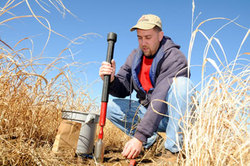Carbon credits may offer farmers new income source
 Kris Brye, collects soil samples for analysis. His research shows changes in cultivation
and tillage practices can improve the ability of soil to store carbon that otherwise
is emitted into the atmosphere as carbon dioxide.
Kris Brye, collects soil samples for analysis. His research shows changes in cultivation
and tillage practices can improve the ability of soil to store carbon that otherwise
is emitted into the atmosphere as carbon dioxide.
FAYETTEVILLE, Ark. — Efforts to reduce greenhouse gas emissions may offer a new source of income for Arkansas farmers.
Federal regulations aimed at reducing carbon dioxide, one of several gases known to contribute to global warming, require industries that expel carbon to lower their emissions, said Kris Brye, a researcher for the University of Arkansas System's Division of Agriculture and an associate professor of crop, soil and environmental sciences for Dale Bumpers College of Agricultural, Food and Life Sciences.
Companies that cannot lower their carbon dioxide emissions sufficiently to meet regulations are allowed to purchase carbon offsets, sometimes referred to as carbon credits. Companies and other entities, including landowners whose land management practices result in a net storage of carbon rather than emission into the atmosphere, sell these offsets, Brye said.
Carbon offsets are traded in North America through the Chicago Climate Exchange, a voluntary, legally binding greenhouse gas reduction and trading system for emission sources. Brye said the Exchange has assigned soil carbon sequestration rates for agricultural land according to continuous tillage and grassland restoration.
"In reality, determining soil carbon sequestration is not that simple," Brye said. "The rate at which carbon is stored in the soil depends on soil texture, climate, management practices, crop rotation and vegetation present."
The amount of soil carbon sequestering that can occur depends on the amount of initial carbon present when management practices change, Brye said. The higher the initial soil carbon is, the slower the rate at which carbon can be sequestered and the smaller the amount that can be stored.
A problem with the Chicago Climate Exchange system, as Brye sees it, is that eastern Arkansas farmland is assigned the same carbon sequestration rates as farmland in the upper Midwest. But he believes those northern lands have a higher initial soil pool than Arkansas because they are richer in carbon-bearing organic matter.
Eastern Arkansas soils generally have a lower initial soil pool, Brye said, because they have a long history of cultivation and because Arkansas has a warmer and wetter climate than upper Midwestern states. That climate stimulates microbial action that converts soil organic matter to carbon dioxide.
"We can't do anything about the climate," Brye said, "but by adopting conservation tillage practices, we can increase carbon sequestration and storage capacity."
Plants take in carbon dioxide for photosynthesis and incorporate the carbon into their own biomass, Brye said. That biomass — mostly roots and other plant material — is what ends up in the soil as organic matter. Tillage and cultivation aerate the soil, which in turn, stimulates microbes living there to eat the organic matter and convert the carbon into carbon dioxide through respiration.
"We can affect carbon dioxide emissions quickly through management practices," Brye said. "We can make an impact immediately."
Brye said the use of conservation tillage — no tillage and minimum tillage — leave the ground virtually undisturbed. Microbial conversion of organic matter to carbon dioxide continues, but at a much slower pace and most of the carbon remains in the ground. Also, Brye recommends not burning residue from previous crops.
"Burning releases carbon dioxide into the atmosphere," Brye said. "It's much more useful to leave it in the soil. Even minimum tillage is better than burning it."
To evaluate carbon sequestration rates in Arkansas, Brye began taking identifying and sampling soils in a dozen or so sites in eastern Arkansas in 2001. He looked for sites where native prairies were adjacent to conventionally tilled agricultural land. "The same soil, different management systems," he said. He analyzed the samples for total carbon sequestration, then waited five or six years.
"Soil carbon varies in time and space," Brye said. "Three to five years between samples is about how long it takes to get a handle on the sequestration rate."
He is analyzing the soils from the second sampling to determine the difference in carbon content. That difference will be the sequestration rates for those soils. He is seeking funding to conduct the same test on agricultural lands where conservation tillage is practiced so he can determine how the sequestration rates in those soils might differ from conventionally tilled land.
While waiting between sampling dates for the initial study, Brye looked for grassland restoration sites in the state for which to study carbon sequestration rates. In 2005, he sampled several sites at the Pea Ridge National Military Park in Benton County.
Based on his findings, Arkansas farmers not already doing so may find it profitable to adopt conservation tillage practices and trade carbon offsets on the Chicago Climate Exchange, Brye said. Besides, he said, another benefit of conservation tillage is that it improves soil fertility.
News releases and photos are available online at
http://arkansasagnews.uark.edu/392.htm